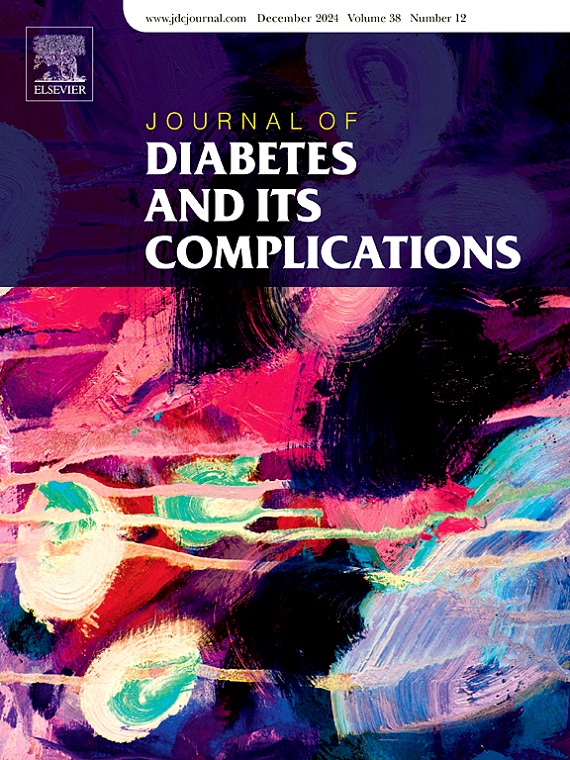胸片上发现的心包脂肪垫与2型糖尿病患者代谢功能障碍相关的脂肪变性肝病和内脏脂肪堆积密切相关
IF 3.1
3区 医学
Q3 ENDOCRINOLOGY & METABOLISM
引用次数: 0
摘要
目的本研究旨在评估胸片上检测到的心包脂肪垫(PFP)是否可以评估代谢功能障碍相关的脂肪变性肝病(MASLD)和内脏脂肪堆积。方法66例2型糖尿病患者根据胸片上PFP存在(n = 40)或不存在(n = 26)进行分类。使用腹部计算机断层扫描评估脐水平的内脏脂肪面积(VFA)和内脏与皮下脂肪面积比(V/S),而使用纤维扫描测量控制衰减参数(CAP)。使用临床参数,包括体重指数(BMI)、血压和生化指标来估计脂肪肝指数(FLI)。结果PFP患者BMI明显增高,且男性比例较高。PFP患者的CAP、FLI、VFA和V/S均显著高于非PFP患者(P分别为0.018、0.005、<; 0.001和0.020)。胸片检测PFP的截止值为CAP≥265.5 dB/m, FLI≥30.6,VFA≥118.7 cm2, V/S≥0.71。结论在2型糖尿病患者中,胸部x线检查PFP可作为MASLD和内脏脂肪堆积的指标。本文章由计算机程序翻译,如有差异,请以英文原文为准。
Pericardial fat pad detected on chest X-ray is closely associated with metabolic dysfunction-associated steatotic liver disease and visceral fat accumulation in patients with type 2 diabetes
Aim
This study aimed to evaluate whether a pericardial fat pad (PFP) detected on chest X-ray can estimate metabolic dysfunction-associated steatotic liver disease (MASLD) and visceral fat accumulation.
Methods
Sixty-six patients with type 2 diabetes were categorized on the basis of the presence (n = 40) or absence (n = 26) of PFP on chest X-ray. The visceral fat area (VFA) and visceral-to-subcutaneous fat area ratio (V/S) at the umbilical level were assessed using abdominal computed tomography, whereas the controlled attenuation parameter (CAP) was measured using FibroScan. The fatty liver index (FLI) was estimated using clinical parameters, including body mass index (BMI), blood pressure, and biochemical markers.
Results
Subjects with PFP had a significantly higher BMI and a higher proportion of males. Subjects with PFP demonstrated significantly higher CAP, FLI, VFA, and V/S than those without PFP (P = 0.018, 0.005, < 0.001, and 0.020, respectively). The cutoff values for detecting PFP on chest X-ray were CAP ≥265.5 dB/m, FLI ≥ 30.6, VFA ≥ 118.7 cm2, and V/S ≥ 0.71.
Conclusions
In patients with type 2 diabetes, PFP detected on chest X-ray may serve as an indicator of MASLD and visceral fat accumulation.
求助全文
通过发布文献求助,成功后即可免费获取论文全文。
去求助
来源期刊

Journal of diabetes and its complications
医学-内分泌学与代谢
CiteScore
5.90
自引率
3.30%
发文量
153
审稿时长
16 days
期刊介绍:
Journal of Diabetes and Its Complications (JDC) is a journal for health care practitioners and researchers, that publishes original research about the pathogenesis, diagnosis and management of diabetes mellitus and its complications. JDC also publishes articles on physiological and molecular aspects of glucose homeostasis.
The primary purpose of JDC is to act as a source of information usable by diabetes practitioners and researchers to increase their knowledge about mechanisms of diabetes and complications development, and promote better management of people with diabetes who are at risk for those complications.
Manuscripts submitted to JDC can report any aspect of basic, translational or clinical research as well as epidemiology. Topics can range broadly from early prediabetes to late-stage complicated diabetes. Topics relevant to basic/translational reports include pancreatic islet dysfunction and insulin resistance, altered adipose tissue function in diabetes, altered neuronal control of glucose homeostasis and mechanisms of drug action. Topics relevant to diabetic complications include diabetic retinopathy, neuropathy and nephropathy; peripheral vascular disease and coronary heart disease; gastrointestinal disorders, renal failure and impotence; and hypertension and hyperlipidemia.
 求助内容:
求助内容: 应助结果提醒方式:
应助结果提醒方式:


